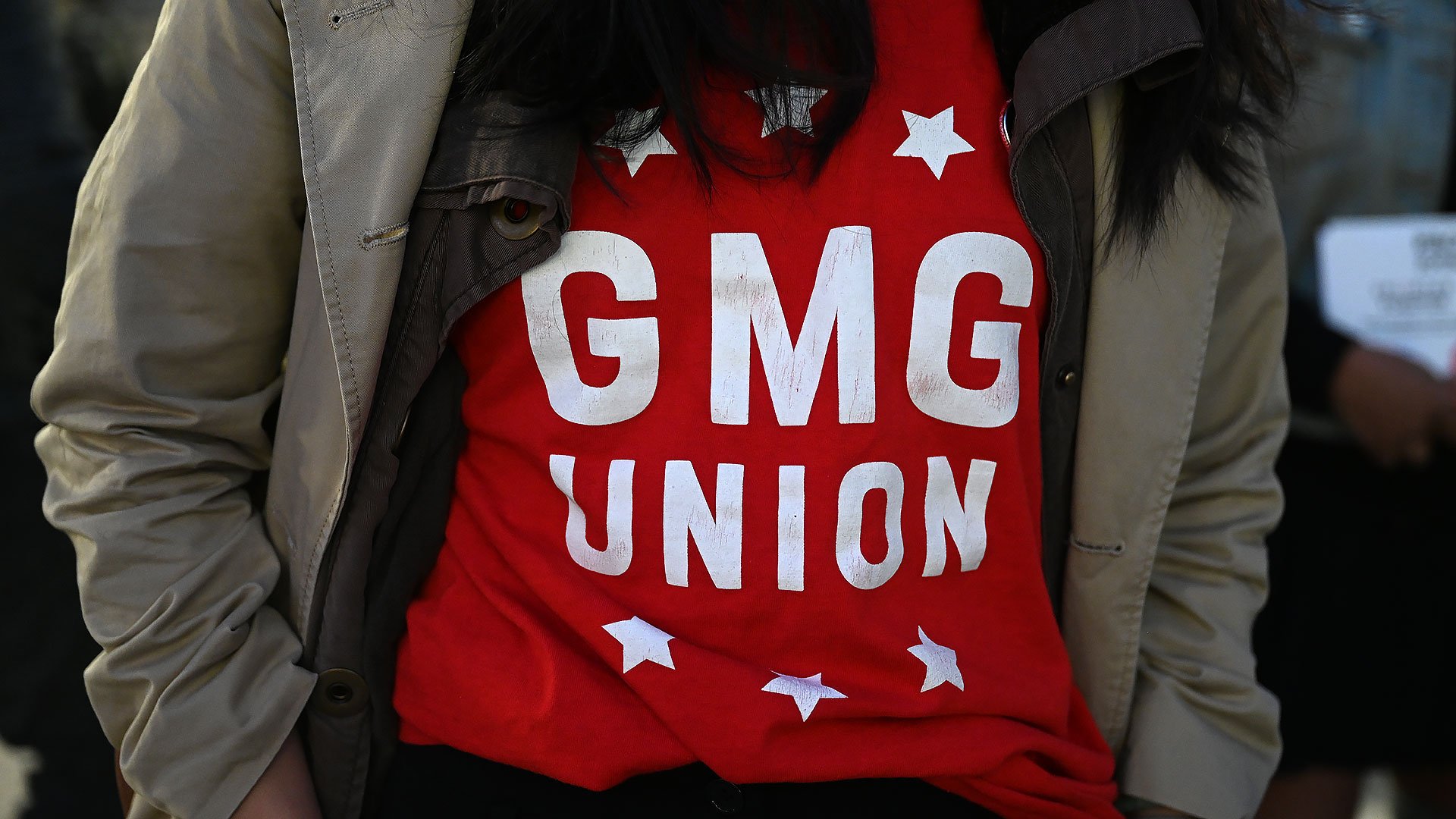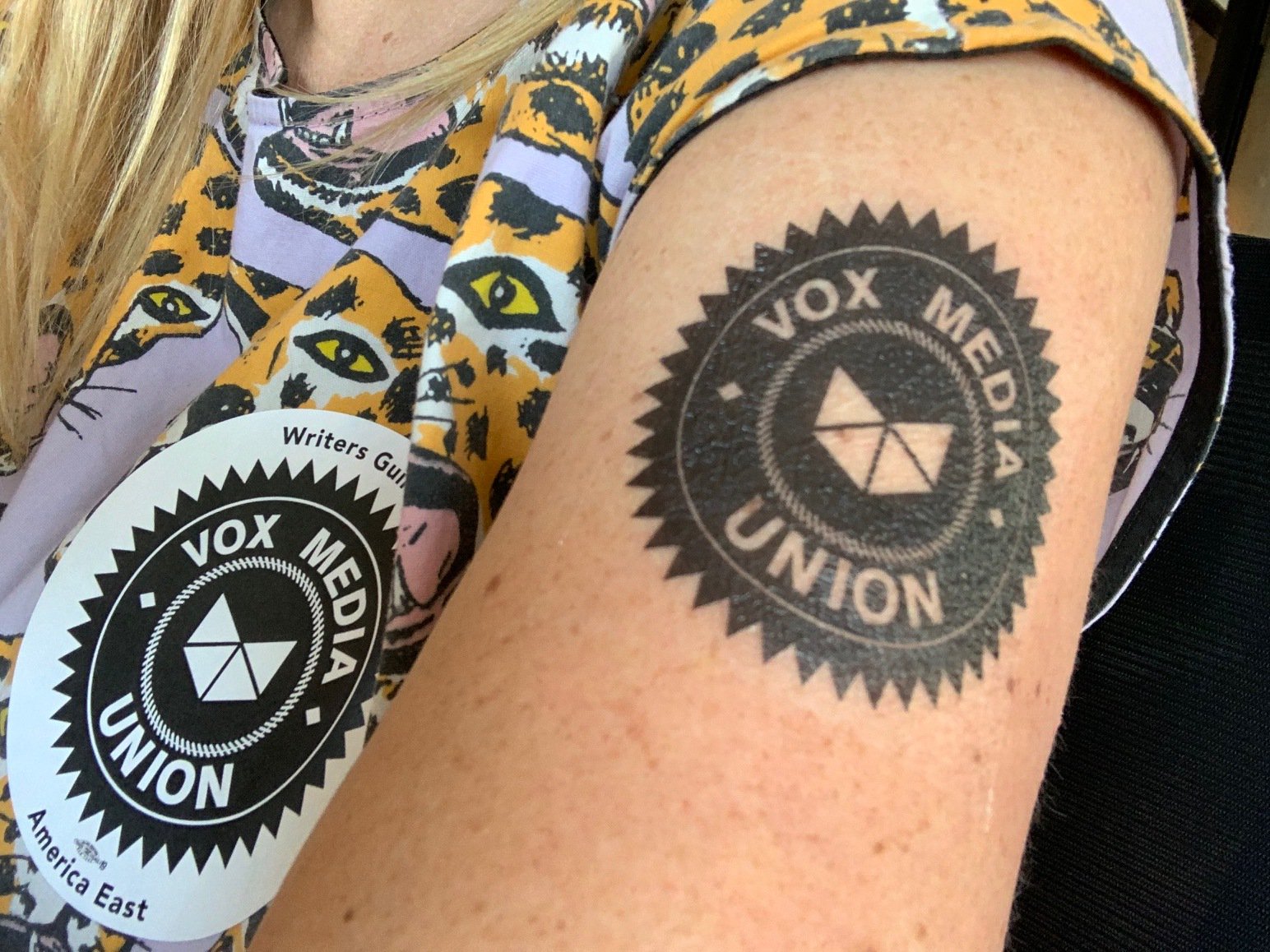In the past decade, workers at news publications have launched more than 200 union drives, and over 90% of them have been successful.
Media outlets have called it a “wave.” But it’s more than that, said University of Toronto associate professor Nicole Cohen. It’s a movement.
And that movement has reached all areas of journalism. Union leaders at newspapers, digital outlets and broadcast stations are seeing record levels of organizing that show little sign of stopping. In 2015 — which many point to as the start of this trend — workers launched 20 union drives. This year, workers may more than double that number.
Last year saw at least 37 union drives where journalists asked formally for union representation; all of them were successful. Workers this year have already organized at least 29 union drives in the first six months of 2021.
The data in this story primarily comes from National Labor Relations Board election reports spanning 2012 to 2021. Unions are allowed to represent workers through one of two ways: voluntary recognition from the employer or an NLRB election.
Unions that receive voluntary recognition have the option of filing paperwork with the NLRB. Because this is not required, there does not exist a complete database of voluntarily recognized unions. In an attempt to capture some of that information, this story also includes data taken from a timeline created by the Cultural Workers Organize project and press releases by the NewsGuild; the Writers Guild of America, East; and the Screen Actors Guild-American Federation of Television and Radio Artists.
Not everyone who works in journalism is a reporter, so the data also includes union drives by other groups, like camera operators and tech workers. We’ve tried to include all unionization efforts that have taken place at organizations that produce news in some capacity. If we’ve missed any, please let us know.
‘We’ve got to do something’
Leaders at three of the largest unions representing journalists are unanimous — what’s happening now is historic.
“I started with AFTRA in 1995. I can tell you what we’re seeing in the last five years is unlike anything I’ve seen before in terms of organizing,” said Mary Cavallaro, chief broadcast officer of the SAG-AFTRA News and Broadcast Department. In addition to actors, artists and radio personalities, the union represents a number of journalists.
The flurry of union activity follows a dry spell for the NewsGuild especially, said Cohen, who recently co-authored a book about union organizing in digital media. The largest union for journalists, the NewsGuild organized a number of papers in the 1930s shortly after it was founded. But in recent decades, as newsrooms shrank and union membership across most industries decreased, the NewsGuild had to switch to defensive work to protect their contracts.
All that changed in 2015. That year Gawker Media became the first major online media company to organize after workers announced they were unionizing with the Writers Guild, which represents broadcast and digital journalists in addition to film and television writers. The next few months saw a spate of activity as other digital news sites like Salon, Vice and HuffPost unionized with the Writer’s Guild. Meanwhile, the NewsGuild organized shops at the Guardian US and Al Jazeera America.
Many workers in recent years have cited similar motivations for organizing — low pay, few benefits, pay inequity. But other reasons for the uptick in union activity are specific to the type of news organization in question.
For example, journalists at digital outlets in the mid-2010s wanted to formalize rules governing their work. Digital news sites were growing rapidly at the time and were “loosely organized” and “bootstrappy,” Cohen said. Journalists looking to make their careers at these places believed that unionizing would make processes like hiring, promotions and firing more transparent.
“It may be that some years ago, (digital media) was a temporary waystation on the way to a newspaper job or a broadcast job,” said Writers Guild executive director Lowell Peterson. “I think it has become a place for journalists to make their careers in and of itself, and that has led them to ponder the question of, ‘Well, how do I make my career more viable? How do I get some say about my own work life?’”
With the advent of business initiatives like sponsored content, digital outlets also saw a rise in content that blurred the lines between advertising and editorial work, Cohen said. Some journalists saw unionizing as a way to protect the editorial integrity of their work.
That desire to protect the quality of one’s work has also been a driving force behind the unionization movement within the broadcast space. As TV networks and stations developed their digital platforms and social media presences, broadcast journalists found they had increasing responsibilities.
“There’s a real concern for the quality of the work — that they be able to have the time and the resources to focus on quality in addition to feeding all of those different platforms,” Cavallaro said.
Those additional responsibilities mean that journalists are working longer hours. As a result, reporters are looking for adequate compensation for that extra work. They also want to ensure that assignments are being distributed equitably and that they have the opportunity to develop their own ideas.

DNAinfo and Gothamist employees rally in New York City in November 2017. (Writers Guild of America, East)
Among newspaper workers, industry instability has led many to unionize. Newsroom employment at papers dropped by 51% percent between 2008 and 2019, and the industry is seeing increasing consolidation as private equity firms and hedge funds buy up papers. Many new unions’ mission statements reference a desire to combat the local news crisis, and a number of journalists have decided to organize after a change in their paper’s ownership.
“When we see the purchase of newspaper chains by these private equity and hedge funds, immediately they start slashing jobs,” said Florida State University professor Jennifer Proffitt, who studies labor issues at newspapers. “There are fewer journalists trying to do more, and it just puts a real strain on the newspapers. And I think that from my interviews with journalists and what I’ve read, this (unionizing) is journalists’ way to try to stop the bleeding.”
Finally, the social and political climate has helped make unionizing more appealing. Diversity in hiring and coverage remains a key priority among many media unions, and more and more journalists see unionizing as a way of effecting change.
“Our organizing victory started before the previous presidential administration, but I think the politics really matter. Being engaged in conversations about social justice issues really matters,” Peterson said. “I don’t think they’re unionizing as a political stance, but I think the general climate is ‘We’ve got to do something, and we’ve got to get active. We can’t just passively accept what’s happening in our newsroom.’”
What sets newsroom unions apart
Union membership has been steadily declining for the past 40 years, but certain groups are bucking the trend. Journalism is one of them.
In 1983, the union membership rate was 20.1%, according to the Bureau of Labor Statistics. In 2020, just 10.8% of wage and salary workers were members of unions. Those numbers obscure the fact that labor activity is resurging among groups not traditionally associated with union membership, like tech workers, museum workers, artists, academics and graduate students.
“I think that this kind of resurgence of knowledge workers or cultural workers or media workers or white collar workers — whatever people may think about calling them — I think there’s been a resurgence of class consciousness and labor organizing in those sectors, and I think it inspires and kind of motivates one another,” Cohen said.
Journalists are increasingly viewing unionization as a positive thing. They’re eschewing old expectations that unionizing means discontent with the workplace and instead organizing because they want to help their colleagues and have a positive impact on their workplace, Cavallaro said.

Gawker Media employees unionized in June 2015, making it the first major digital media newsroom to form a union. Due to mergers, the Gawker Media union is now part of the GMG Union, along with employees from Fusion and The Root. (Writers Guild of America, East)
One striking aspect of the current unionization movement in journalism is the high success rate among union drives that were made public. NewsGuild president Jon Schleuss noted that last year, the guild had 47 union drives (not all of them in newsrooms) and 47 of them were successful.
(It is unclear how many unionization attempts have stalled or failed in their early stages, before workers publicized their efforts).
NLRB election reports show that the last time the NewsGuild lost an election at a newsroom was in 2012 at the Center for Investigative Reporting. The Writers Guild hasn’t lost a single election to unionize a newsroom between 2012 and now.
Since the start of its organizing frenzy in 2015, newsroom shops within the Writers Guild have almost always received voluntary recognition. The NewsGuild and SAG-AFTRA, however, have to go to the NLRB more frequently. Cavallaro said that union drives at places where part of the workforce has already unionized often receive voluntary recognition after employers check union cards.
The success rate for NLRB elections in the past decade has hovered between 65% and 72%. For union drives at news companies in recent years, that rate regularly tops 80%.
There are several reasons for this. Cohen said the nature of the media industry makes it easier for journalists to organize. Workers from different outlets regularly interact, and journalists are good communicators. Many new unions, especially ones organized by reporters, launch extensive social media campaigns that help build up momentum and support, pressuring employers to grant voluntary recognition.
Journalists also change jobs relatively frequently. Cohen said that over the course of her research, she has spoken to people who have organized a drive in one newsroom before moving to another place and unionizing that one, too.
But the biggest reason for the high success rate is the conservative, bottom-up approach unions take when organizing new shops. SAG-AFTRA, the Writers Guild and the NewsGuild all wait until they have a clear majority before publicizing their union drives. They also allow journalists to shape the union’s priorities and take charge of organizing efforts.
“We are very, very intent on this being a grassroots, worker-driven organizing drive,” said SAG-AFTRA organizing director Maggie Russell-Brown. “It creates a much stronger union. It creates a stronger organization. And there’s ownership of the process versus a sort of top-down or ‘this is what you’re going to get’ (approach).”
What’s next

The Vox Media Union was voluntarily recognized in January 2018. (Writers Guild of America, East)
Experts and union leaders agree that the end of the movement is nowhere in sight. In June alone, at least five newsrooms announced union drives.
Some of the trends driving unionization efforts, like layoffs and newspaper consolidation, are only accelerating and will continue to fuel the movement, said Florida State University professor Jennifer Proffitt. The pandemic has further destabilized the industry. More than 70 newspapers have closed their doors, and thousands have lost their jobs. Many papers also saw declines in revenue during the pandemic, and unions are forming in an attempt to provide job security.
“COVID is a factor as well,” Proffitt said. “The advertising and all of that has shrunk with COVID, which puts even more burdens on newspapers.”
Unionizing also leads to more unionizing. Journalists who had once been wary of organizing are seeing the benefits union contracts provide at other news outlets. Sometimes they don’t have to look far to see those benefits. A number of recent drives have taken place at news organizations that already have unions in place. More than 650 tech workers at The New York Times, for example, are trying to join their 1,400 unionized colleagues.
Changes in technology have caused corresponding shifts in journalism. It’s not just writers or anchors who get to be journalists. As new positions and outlets emerge, it is almost inevitable that the unionization movement will reach them, too.
At SAG-AFTRA, that means organizers are seeing more and more producers requesting union representation after the rise of digital platforms changed the nature of their work. Meanwhile, the Writers Guild recently organized workers at CBSN, making it the first livestreamed digital news network to unionize.
“There are additional communications, news content sectors. We’re doing a lot in podcasting, for example, and that will continue to expand,” said Writers Guild executive director Lowell Peterson. “I think the industries where we represent writers and producers and so forth are going to continue to surprise us with the way they transform. And as part of that, people will remain eager to be represented.”







